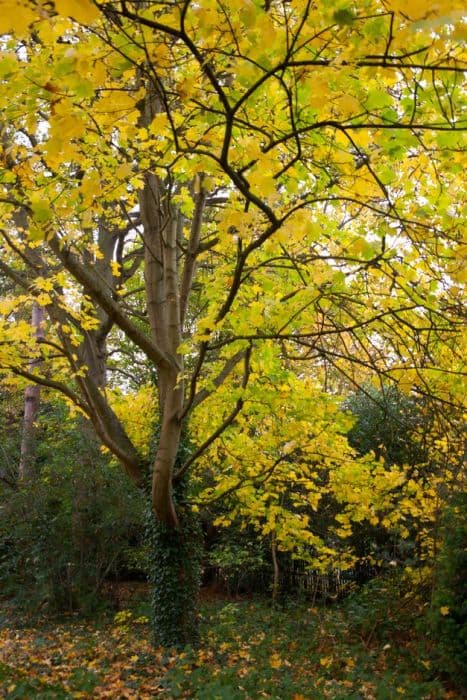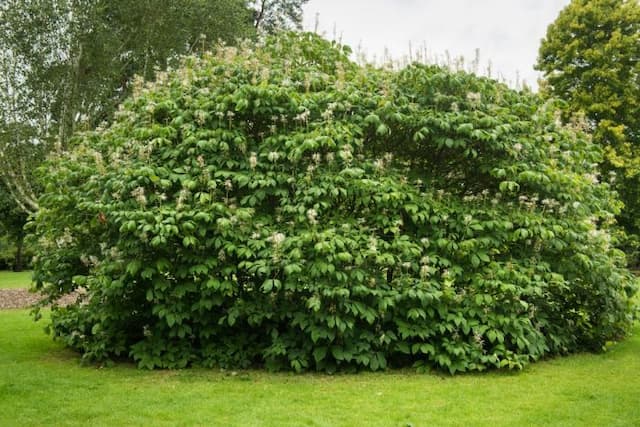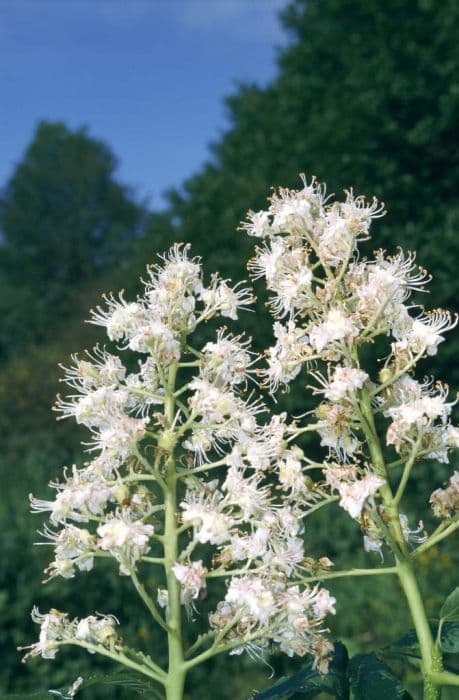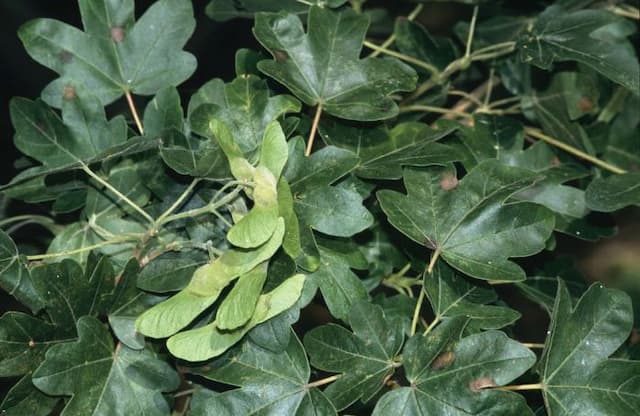Japanese Maple Acer palmatum 'Kinshi' (L)

ABOUT
The Japanese maple 'Kinshi', is an ornamental plant known for its elegant foliage and striking visual appeal. It boasts finely cut leaves that have a lace-like appearance, adding a delicate texture to the landscape. The leaves are arranged in a distinctive palmate pattern, resembling an open hand with outstretched fingers. As the seasons change, the 'Kinshi' exhibits a vivid array of colors. In spring, the new foliage emerges with a fresh, golden-yellow hue, often with undertones of light green, making it a bright addition to any garden. Through the summer months, the leaves transform into a rich, green color, providing a cool and lush canopy. Come fall, the 'Kinshi' turns into a spectacle of colors. The foliage can display a variety of shades, including warm golds, deep oranges, and sometimes vivid reds, creating a dramatic contrast against the often duller colors in the landscape. The tree's overall shape contributes to its ornamental value. With its elegant branching pattern, it creates an intricate network that is especially visible and appreciated during the winter when the leaves have fallen. The bark of this tree adds to its year-round interest, with a smooth texture that may become slightly roughened as the tree matures. Overall, the Japanese maple 'Kinshi' is a highly prized plant for its sophisticated appearance, fine-textured leaves, and brilliant seasonal color transformation. It serves as an elegant focal point in gardens and is equally beautiful when used as a standalone specimen or when integrated into a collection of complementary plants.
About this plant
 Names
NamesFamily
Sapindaceae
Synonyms
Golden Full Moon Maple, Kinshi Japanese Maple
Common names
Acer palmatum 'Kinshi'
 Toxicity
ToxicityTo humans
Japanese maple, including the 'Kinshi' variety, is generally not considered toxic to humans. Therefore, ingesting parts of the plant typically does not cause poisoning or severe health consequences. However, as with any plant, individual allergic reactions or sensitivities can occur, so it is always prudent to handle plants with care and avoid ingestion if uncertain.
To pets
Japanese maple, including the 'Kinshi' variety, is also not considered toxic to pets such as dogs and cats. It should not cause any significant symptoms of poisoning or serious health consequences if ingested. Nonetheless, it's always best to prevent pets from eating plants as digestive issues can occur from the ingestion of non-food items, and individual pets may have allergies or sensitivities.
 Characteristics
CharacteristicsLife cycle
Perennials
Foliage type
Deciduous
Color of leaves
Green
Height
6-8 feet (1.8-2.4 meters)
Spread
6-8 feet (1.8-2.4 meters)
Plant type
Tree
Hardiness zones
5-9
Native area
Japan
Benefits
 General Benefits
General Benefits- Ornamental Appeal: 'Kinshi' Japanese maple provides aesthetic beauty with its unique, feathery foliage and striking fall colors, adding visual interest to any garden.
- Shade Provision: With its spreading canopy, it can offer a cool, shaded area during hot summer months.
- Wildlife Habitat: It can serve as a habitat for birds and other wildlife, which find shelter and food in its branches.
- Seasonal Interest: It offers year-round visual appeal with changing leaf colors across seasons - bright greens in spring, deepening hues in summer, and vivid yellows, oranges, or reds in fall.
- Size Suitability: Reaching moderate heights, it is suitable for smaller gardens or spaces where a large tree would be impractical.
- Low Maintenance: Once established, it requires minimal care apart from occasional pruning and watering, making it suitable for both novice and experienced gardeners.
- Climate Adaptability: It can adapt to a range of climates, although it prefers temperate regions.
 Medical Properties
Medical PropertiesThis plant is not used for medical purposes.
 Air-purifying Qualities
Air-purifying QualitiesThis plant is not specifically known for air purifying qualities.
 Other Uses
Other Uses- Photography Background - Acer palmatum, commonly known as Japanese Maple, can provide a stunning backdrop for photographers, especially when its foliage changes color in the fall.
- Bonsai - The 'Kinshi' cultivar, like many Japanese Maples, can be trained as a bonsai, providing a miniature landscape feature for enthusiasts.
- Printmaking - Leaves of the Japanese Maple can be used for botanical printmaking and art projects due to their distinctive shape and texture.
- Cultural Symbolism - In Japan, the plant is often used in gardens to represent peace and beauty, and it is also tied to cultural traditions and festivities.
- Education - Japanese Maple is used in educational settings for demonstration of pruning techniques and plant biology due to its interesting growth patterns and foliage.
- Architectural Inspiration - The intricate branching pattern and delicate leaves of the 'Kinshi' can inspire design elements in architecture and decorative arts.
- Leaf Casts - Creating casts of the delicate leaves can be used in crafting and art, capturing the intricate vein patterns in different materials.
- Seasonal Celebrations - Branches and leaves of the Japanese Maple can be used in seasonal displays and arrangements, particularly in autumn-themed decor.
- Culinary Presentation - While not edible, leaves of the Japanese Maple may be used as a decorative garnish for plating high-end cuisine, to add a touch of elegance.
- Film and Theater Sets - Due to its unique and ornamental appearance, the Japanese Maple can be used to create atmosphere in film and theater set designs.
Interesting Facts
 Feng Shui
Feng ShuiThe Japanese Maple is not traditionally used in Feng Shui practice.
 Zodiac Sign Compitability
Zodiac Sign CompitabilityThe Japanese Maple is not used in astrology practice.
 Plant Symbolism
Plant Symbolism- Uniqueness: The 'Kinshi' variety of Japanese Maple is known for its distinctive foliage, symbolizing the beauty of being unique.
- Peace: In Japanese culture, the maple tree is often associated with peace and serenity, representing calmness.
- Elegance: With its graceful structure and leaves, the Japanese Maple is a symbol of elegance and refinement.
- Endurance: As the Japanese Maple can withstand various climates and conditions, it represents the ability to endure and persist through challenges.
- Balance: The balanced growth of the Acer palmatum 'Kinshi' reflects harmony in nature, symbolizing the importance of balance in life.
 Water
WaterJapanese Maple 'Kinshi' should be watered deeply but infrequently, to encourage robust root systems. Typically, water once a week, providing enough water to penetrate the soil to a depth of about 6 inches. During hot or windy weather, you may need to water twice a week. A mature tree in the landscape might require around 10 gallons per week, while potted specimens will depend on pot size but usually require less – approximately 1-2 gallons. Always check the soil moisture before watering; it should be moist but not saturated. Avoid shallow, frequent waterings as they promote weak root development and could lead to health problems.
 Light
LightJapanese Maple 'Kinshi' prefers dappled sunlight or partial shade. A spot that gets morning sun and afternoon shade is ideal to protect the delicate foliage from harsh midday sun. It can tolerate full sun in cooler climates, but in warmer zones, too much direct sunlight may cause leaf scorch.
 Temperature
TemperatureJapanese Maple 'Kinshi' thrives in temperatures that average between 60 to 80 degrees Fahrenheit but can withstand brief periods of colder temperatures down to about -10 to -20 degrees Fahrenheit. Avoid exposure to harsh winds and sudden temperature drops, which can damage the tree. The ideal temperature range facilitates optimal growth and vibrant leaf color.
 Pruning
PruningPrune Japanese Maple 'Kinshi' primarily to remove dead or damaged branches, enhance shape, and encourage healthy growth. The best time for pruning is in the late winter to early spring, before new growth starts. Light pruning can be done throughout the year, but major cuts should be limited to the dormant season. Prune sparingly, as this species does not require heavy pruning to maintain its natural beauty.
 Cleaning
CleaningAs needed
 Soil
SoilJapanese Maple 'Kinshi' thrives in a mixture of 50% pumice, 25% lava rock, and 25% pine bark with a pH of 5.5 to 6.5, ensuring good drainage while retaining moisture.
 Repotting
RepottingJapanese Maple 'Kinshi' should be repotted every two to three years in the spring, before the onset of new growth, to refresh the soil and encourage healthy roots.
 Humidity & Misting
Humidity & MistingJapanese Maple 'Kinshi' prefers average to high humidity levels but is adaptable to outdoor ambient humidity as long as soil moisture is consistent.
 Suitable locations
Suitable locationsIndoor
Place in bright, indirect light with some direct morning sun.
Outdoor
Plant in dappled shade with shelter from strong winds.
Hardiness zone
5-8 USDA
 Life cycle
Life cycleAcer palmatum 'Kinshi', commonly known as Japanese maple 'Kinshi', begins its life as a seed, which upon germinating in favorable conditions of moisture and temperature, develops into a seedling. The seedling grows through a juvenile phase, where it establishes a root system and produces its iconic, finely dissected leaves in a range of colors from green to deep red, depending on the season. As the plant matures, it enters a vegetative stage, characterized by increased growth in height and width, along with the development of a woody stem and branching structure. The mature Japanese maple 'Kinshi' reaches reproductive maturity, flowering in the spring with small, inconspicuous flowers followed by the production of winged samaras (seed pods) that disperse with the wind. After reproduction, it enters a period of senescence over many years, where growth slows and the tree may experience reduced vigor before eventually dying. Throughout its life, the Japanese maple 'Kinshi' goes through annual cycles of growth in spring and summer, followed by a period of dormancy in autumn and winter when leaves fall, conserving energy for the next growing season.
 Propogation
PropogationPropogation time
Early spring to summer
The Japanese Maple 'Kinshi,' known for its distinctive lacy leaves, is most commonly propagated by softwood cuttings or grafting, but the preferred method among many gardeners is grafting onto rootstocks of more vigorous Acer species. Grafting typically occurs during the late winter months leading into early spring before the sap starts to flow. The scion wood, which is a cutting from the 'Kinshi' Japanese Maple, should be selected when it is dormant and have two or three sets of buds. This scion is then carefully joined to a compatible rootstock through methods such as whip and tongue grafting or side veneer grafting, ensuring both cambial layers are aligned. The grafted union is then securely wrapped and allowed to heal over several weeks to months in a controlled environment, promoting successful growth and development of a new 'Kinshi' Japanese Maple tree.









